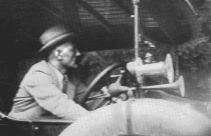
Gurdjieff International Review
Editorial Introduction
A Focus on Historical Essays
This issue contains several historical essays by some of the major students of Gurdjieff and his teaching. We begin with a study of Beelzebub’s Tales written by John G. Bennett in 1950. Bennett grapples with the contradiction of trying to elucidate a “book that defies verbal analysis” and concludes that this epoch-making work represents the first new mythology in 4000 years. Then, George Bennett—John Bennett’s son—sketches the influences that shaped his father’s spiritual search.
Next we focus on Martin Seymour-Smith’s latest book, The 100 Most Influential Books Ever Published. Walter Driscoll reviews this book and observes that “Each of the 100 reviews provides a historical background, an overview of the text, the author, and the factors determining the significance of a particular book, as well as analysis of why the book is of enduring significance today.” We also bring you in its entirety ‘Chapter 94’ of this book which highlights Beelzebub’s Tales to His Grandson. This marks the first time that Beelzebub’s Tales has been included in a ‘best books’ compendium.
We also include Mrs. A. L. Staveley’s succinct jacket notes used on the Two Rivers Press facsimile edition of the 1950 text for Beelzebub’s Tales. This marks the first time we have published anything by this deeply respected student of Gurdjieff and Jane Heap. We hope to bring you more in the future.
Jyri Paloheimo reviews Paul Davies’ Superforce: The Search for a Grand Unified Theory of Nature and takes issue with the popular notion that the current science of physics is yet one more Way in harmony with Eastern teachings. In so doing, he draws on Beelzebub’s Tales as a source and synthesis of ancient wisdom traditions which are rooted in the idea that the universe has a purpose.
A. R. Orage returned to live in England in 1930 after six years in New York where he taught Gurdjieff’s system. Louise Welch, author of Orage with Gurdjieff in America (1982), was in Orage’s group there. She provides a short profile of this remarkable man. We are also pleased to include the first complete republication of the diary entries titled My Note Book which Orage published during 1933 and 1934. They represent his mature thought on a variety of literary, social, psychological and religious topics. The last entry in October 1934 was published just before Orage died on the night of November 5, 1934.
Claude Bragdon, who undertook the first English translation of Tertium Organum in 1920, provides a perceptive analysis of P. D. Ouspensky’s romantic idealism. This contrasts sharply with Marie Seton’s observations. A writer and translator who knew Russian, Seton was Ouspensky’s secretary and confidante during the 1940s in New York. Although grateful to him for what he taught her, and convinced of his goodness and honesty, she writes pointedly of how she saw the role of guru as a corrupting influence on him during that period.
We conclude with an anonymous commentary on Rodney Collin’s The Theory of Celestial Influence. The reviewer characterizes the book as Collin’s monumental attempt to reconstruct what he received from his teacher, P. D. Ouspensky, and points out that while some of the analogies which Collin employs in his attempt to reconcile scientific, religious and astrological cosmologies “seem naive; some are breathtaking in the range of vision they suggest.”
Greg Loy
Walter Driscoll
|
This webpage © 1999 Gurdjieff Electronic Publishing Featured: Spring 1999 Issue, Vol. II (3) Revision: April 1, 1999 |